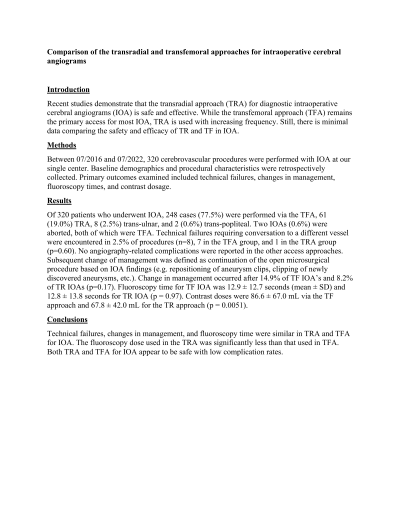Comparison of the transradial and transfemoral approaches for intraoperative cerebral angiograms
Comparison of the Transradial and Transfemoral Approaches for Intraoperative Cerebral Angiograms
Friday, April 21, 2023


Dominic Romeo, MA, MTS
Medical Student
Perelman School of Medicine
Philadelphia, Pennsylvania, United States
ePoster Presenter(s)
Introduction: Recent studies demonstrate that the transradial approach (TRA) for diagnostic intraoperative cerebral angiograms (IOA) is safe and effective. While the transfemoral approach (TFA) remains the primary access for most IOA, TRA is used with increasing frequency. Still, there is minimal data comparing the safety and efficacy of TRA and TFA in IOA.
Methods: Between 07/2016 and 07/2022, 320 cerebrovascular procedures were performed with IOA at our single center. Baseline demographics and procedural characteristics were retrospectively collected. Primary outcomes examined included technical failures, changes in management, fluoroscopy times, and contrast dosage.
Results: Of 320 patients who underwent IOA, 248 cases (77.5%) were performed via TFA, 61 (19.0%) TRA, 8 (2.5%) trans-ulnar, and 2 (0.6%) trans-popliteal. Two IOAs (0.6%) were aborted, both of which were TFA. Technical failures requiring conversation to a different vessel were encountered in 2.5% of procedures (n=8), 7 in the TFA group, and 1 in the TRA group (p=0.60). No angiography-related complications were reported in the other access approaches. Subsequent change of management was defined as continuation of the open microsurgical procedure based on IOA findings (e.g. repositioning of aneurysm clips, clipping of newly discovered aneurysms, etc.). Change in management occurred after 14.9% of TFA IOA’s and 8.2% of TRA IOAs (p=0.17). Fluoroscopy time for TFA IOA was 12.9 ± 12.7 seconds (mean ± SD) and 12.8 ± 13.8 seconds for TRA IOA (p=0.97). Contrast doses were 86.6 ± 67.0 mL via TFA and 67.8 ± 42.0 mL for TRA (p=0.0051).
Conclusion : Technical failures, changes in management, and fluoroscopy time were similar in TRA and TFA for IOA. The fluoroscopy dose used in the TRA was significantly less than that used in TFA. Both TRA and TFA for IOA appear to be safe with low complication rates.
Methods: Between 07/2016 and 07/2022, 320 cerebrovascular procedures were performed with IOA at our single center. Baseline demographics and procedural characteristics were retrospectively collected. Primary outcomes examined included technical failures, changes in management, fluoroscopy times, and contrast dosage.
Results: Of 320 patients who underwent IOA, 248 cases (77.5%) were performed via TFA, 61 (19.0%) TRA, 8 (2.5%) trans-ulnar, and 2 (0.6%) trans-popliteal. Two IOAs (0.6%) were aborted, both of which were TFA. Technical failures requiring conversation to a different vessel were encountered in 2.5% of procedures (n=8), 7 in the TFA group, and 1 in the TRA group (p=0.60). No angiography-related complications were reported in the other access approaches. Subsequent change of management was defined as continuation of the open microsurgical procedure based on IOA findings (e.g. repositioning of aneurysm clips, clipping of newly discovered aneurysms, etc.). Change in management occurred after 14.9% of TFA IOA’s and 8.2% of TRA IOAs (p=0.17). Fluoroscopy time for TFA IOA was 12.9 ± 12.7 seconds (mean ± SD) and 12.8 ± 13.8 seconds for TRA IOA (p=0.97). Contrast doses were 86.6 ± 67.0 mL via TFA and 67.8 ± 42.0 mL for TRA (p=0.0051).
Conclusion : Technical failures, changes in management, and fluoroscopy time were similar in TRA and TFA for IOA. The fluoroscopy dose used in the TRA was significantly less than that used in TFA. Both TRA and TFA for IOA appear to be safe with low complication rates.
